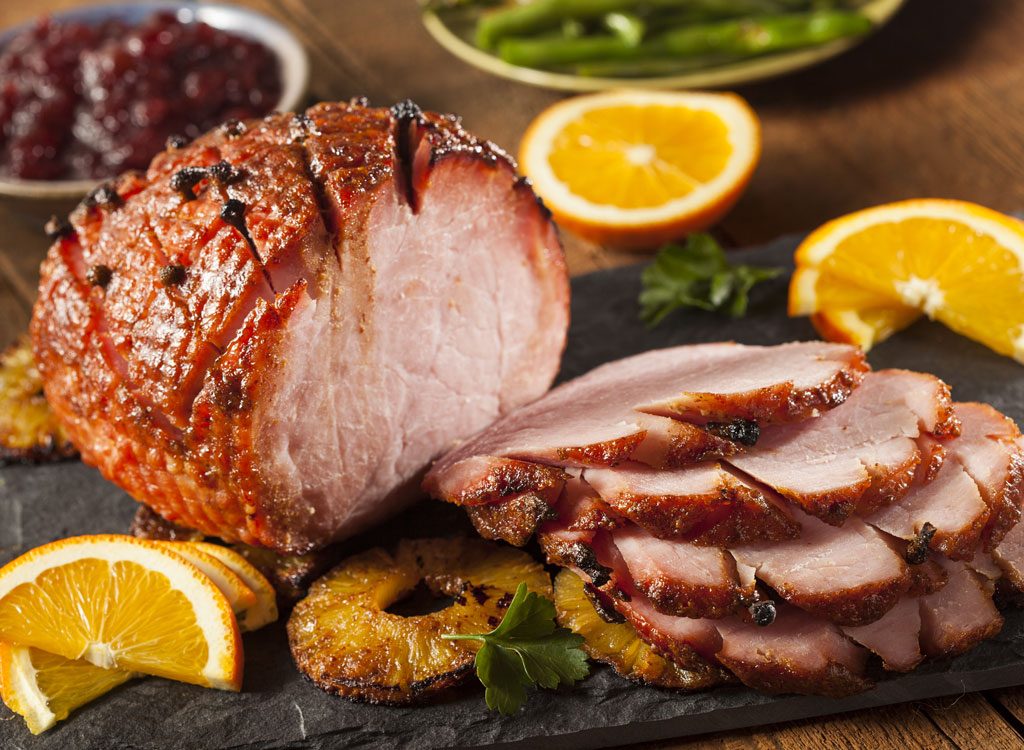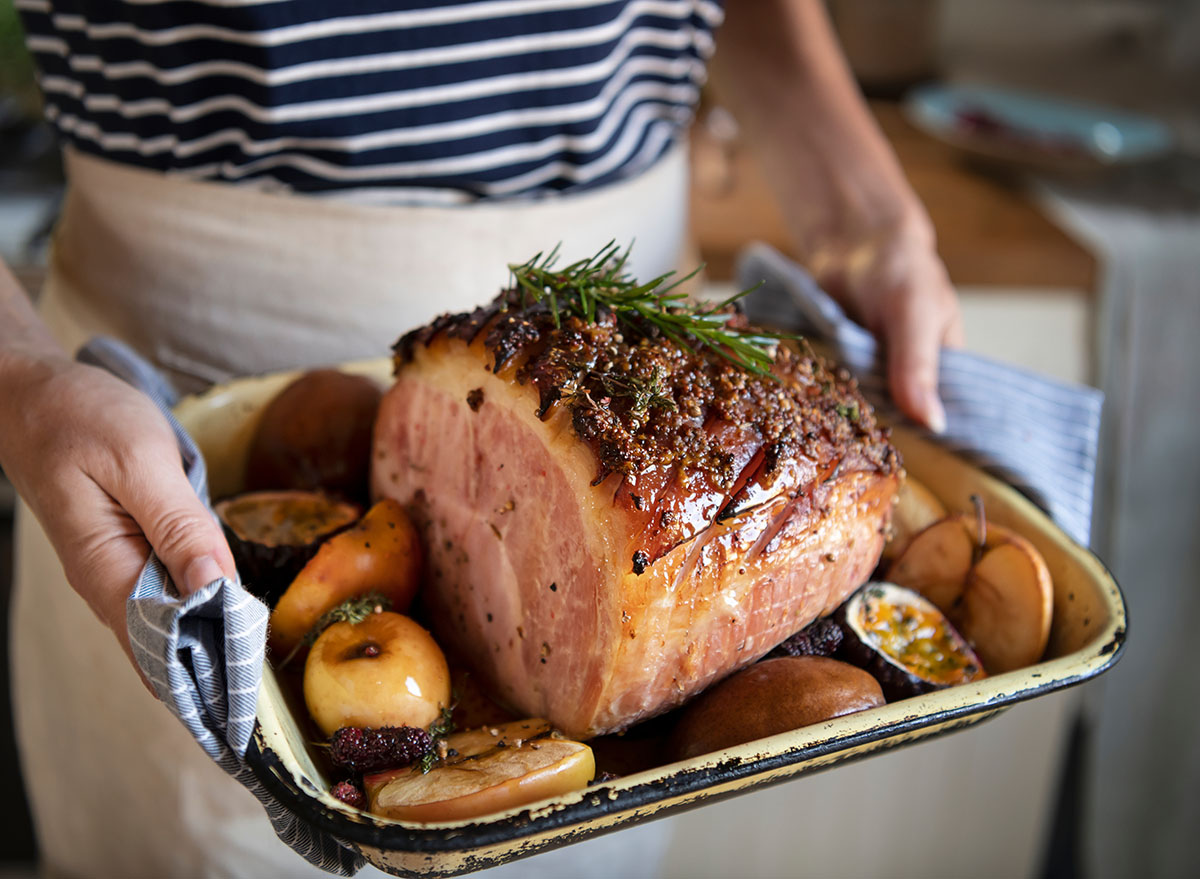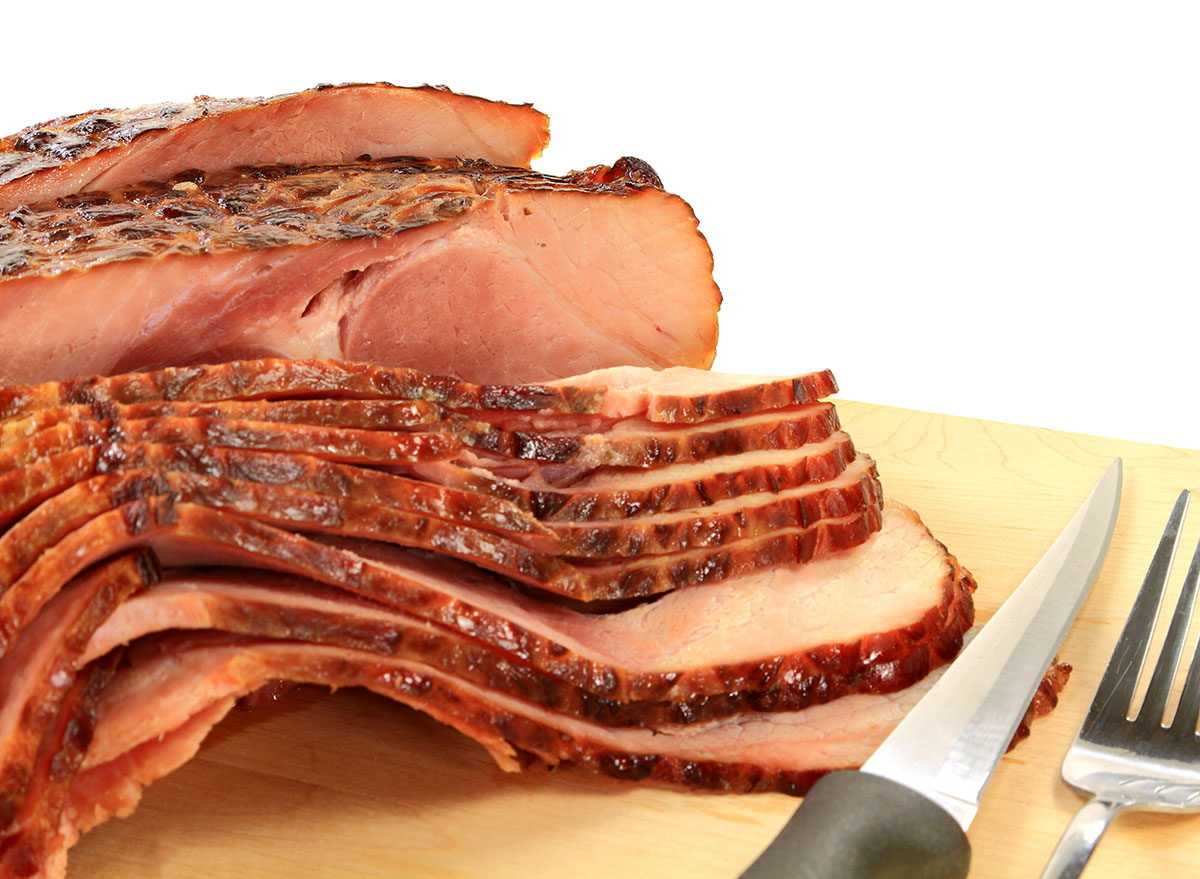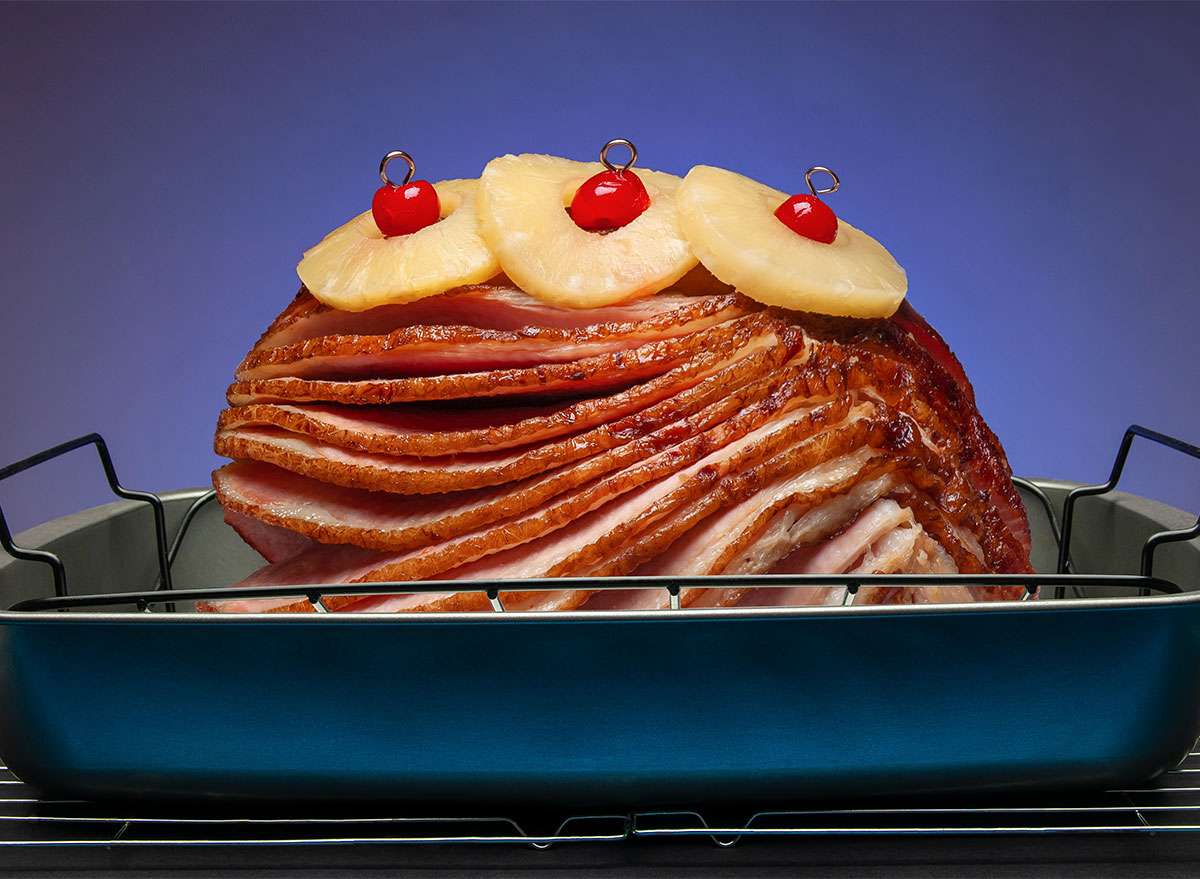
Most hams you buy in the grocery store are cured and already fully cooked. So, when it comes to re-heating this popular holiday main dish, what could possibly go wrong? As it turns out… quite a lot!
From cooking at too high a temperature to scoring your ham incorrectly, there are a whole lot of missteps that can lead to a dried-out ham that's lacking in flavor. Plus, the pressure is on if the ham is the staple of your holiday menu.
We talked to butchers and chefs to find out what ham mistakes people commonly make when they're cooking at home, and we got some tips about how you can consistently make a succulent, flavorful ham.
And for more, don't miss these 15 Classic American Desserts That Deserve a Comeback.
Mistake: Not knowing the differences in ham

Yes, many of the hams that you'll find in stores are pre-cooked, cured hams. But there are also uncooked hams that are salty and cured, like country ham and prosciutto, says Whole Foods' Vice President of Meat and Poultry, Theo Weening. Also, there are bone-in hams, completely boneless hams, and ones that have a middle bone and that are usually pre-sliced.
How to fix it: Talk to the butcher behind the meat counter, Weening suggests. Butchers will be able to guide you to the right type of ham depending on the holiday hosting scenario and the type of meal you're trying to serve, he says. Boneless hams, for example, may be easier to cut, but a bone-in ham tends to hold more flavor.
Mistake: Cutting too-thick slices of country ham

If you do go the country ham route, cutting too-thick of slices will lead to salty, hard pieces of meat ending up on people's plates, cautions Christian Graves, the executive chef at Citizen Rail in Denver, Colorado.
How to fix it: Graves is a fan of country-style ham. His serving suggestion: "Slice it thin to win!"
Mistake: Buying a ham with larger water content

Hams with higher water percentages tend to be cheaper, but you'll miss out on flavor.
How to fix it: Look for hams that are labeled "ham" and steer clear of those that have labels such as "ham, water added" or "ham and water product."
Mistake: Not taking a good look at your ham first

"Most ham sold in supermarkets is sold vacuum packed, and if there is cloudy liquid in the pack, it shows that the ham has been in the pack a long time," cautions Dave Lang, a meat expert and butcher with more than 40 years of experience.
How to fix it: Avoid purchasing a ham if you spot cloudy liquid, Lang says. Also, when you get the ham home and take it out of the pack, rinse it under cold running water to wash off the excess salt, he suggests.
Mistake: Buying tough-to-carve cuts

You want an easy-to-slice ham so that you can serve everyone quickly, while the ham is still hot.
How to fix it: For easy carving, buy a shank-end, spiral-sliced ham, says Morgan Bolling, deputy food editor at Cook's Country and meat expert at America's Test Kitchen. A whole ham is the entire back leg of the pig, she explains, but it's often split and sold as a "butt" (sometimes called "sirloin") portion and the "shank" portion.
The butt portion is more domed and has odd-shaped bones, making it harder to carve, she says. The shank is lower down the leg with a more simple bone structure. If they're not labeled, look for the roasts that are more conical in shape with a tapered, pointed end—that should be from the shank portion.
Mistake: Forgetting to remove the ham from its packaging

No judgment here. But plastic in the oven is never a good thing.
How to fix it: "Be sure to remove your ham from the packaging it comes in," Weening says. "This may sound like a given, but I've seen it happen, so place your ham on an oven-friendly surface when reheating."
Mistake: Not cooking your ham with any liquid

Want a succulent, flavorful ham? Of course you do! But if you forget to call in a braising liquid for back-up, you risk your holiday ham coming out of the oven disappointingly dry.
How to fix it: Cook your ham in a chicken broth, orange juice, apple juice, or cider vinegar, suggests Ryker Brown, the executive chef at the Omni Nashville Hotel. A braising liquid spiced with clove, cardamom, anise, and sage adds a nice flavor, Brown says.
Mistake: Scoring your ham too deep

Putting crisscrosses at the top of your ham is a good idea! It can help the glaze seep in and distribute those sweet maple and brown sugar flavors. But, if you slice too deep your ham can—you guessed it—dry out, says Christina Roy, chef de cuisine at Omni Mount Washington Resort in New Hampshire.
How to fix it: Only score into the ham about 1/4 of an inch, Roy says, and cook low and slow.
Mistake: Glazing your ham too early

"People sometimes think glazing and basting is the same technique, and they end up with a burnt ham," says Joseph Man, the banquet chef at the Omni King Edward Hotel in Toronto.
How to fix it: Refrain from glazing your ham until the final 30 minutes that your ham is cooking, Man suggests. Then, turn your oven up to 400 degrees Fahrenheit, and the glaze will cook nicely into the rind.
Mistake: Relying only on the seasoning packets

Most store-bought hams come with a seasoning packet. The problem? That paltry packet of spices is rarely enough to wow everyone, says Trish Koetting, co-owner of Hoss's Market in Columbia, Missouri.
How to fix it: Dress up your ham with cloves, orange slices with the rind, brown sugar, and dijon mustard for an extra flavorful glaze, she says.
Mistake: Not covering your ham

Uncovered, a ham can quickly dry out. Put aluminum foil or an oven bag on your holiday grocery list.
How to fix it: The ham should be covered for at least half of the cooking time, says Executive Chef Dan Matthiesen of the temporarily-closed Bookstore Bar & Café in Seattle. "Only remove the cover during the last half for the glazing process," he says.
Mistake: Not using an oven bag

While foil will do, going the extra mile with an oven bag works even better. The air in your oven is dry, explains Bolling. An oven bag will cook your ham more gently.
How to fix it: Cook your ham in an oven bag, which traps juices and creates a moist environment, Bolling says.
Mistake: Pre-slicing your ham

Wait, don't slice the ham just yet! If you slice it and then put it back in the oven to keep it warm while your family is gathering at the table, the ham can dry out, says Chef Joshua Smith, owner of New England Charcuterie and director of culinary innovation for Alltown Fresh convenience market.
How to fix it: "Make sure the table is set and guests are proceeding to sit, then quickly slice your ham to ensure that it's nice and hot and full of flavor," he says.
Mistake: Cooking the ham at too high of a temperature

Because most holiday hams aren't sold raw, you cook ham at a lower temperature than other meats, which often throws home chefs off. "You don't want the temperature to be too hot or else it will dry out the meat," says Weening.
How to fix it: Low and slow is the name of the game, chefs tell us. Weening recommends cooking your ham between 275 and 300 degrees Fahrenheit.
Mistake: Not letting your ham cook long enough

Cold, cooked ham is great on sandwiches; not so great at the dinner table.
How to fix it: Your ham should reach an internal temperature of 145 degrees Fahrenheit with a three-minute rest time, according to food safety guidelines. Koetting recommends serving ham when it's hot, between 145 and 165 degrees Fahrenheit.
Mistake: Not having a thermometer handy

People often forget to invest in a reliable meat thermometer, says Koetting.
How to fix it: Stick the thermometer in the thickest part of the ham and check the temperature of your ham every 30 minutes, she says.
Mistake: Not glazing your ham frequently enough

Glazing isn't a one-and-done job. Even though cooking a ham is largely a re-heating process, it's pretty hands-on because of the glazing process.
How to fix it: The glazing process should start around the halfway mark of the cooking process, Matthiesen says. Once the glazing process has started, continuing layering glaze on your ham every 10 to 15 minutes.
Mistake: Not buying enough ham

You want there to be enough ham to go around the table (and enough left over for sandwiches the following day).
How to fix it: A good rule of thumb is to buy 1/2 pound of ham for every person if you're purchasing a boneless ham, and 3/4 pound of ham for every person if it's a bone-in ham.
Mistake: Cooking your ham for too long

Again, too much time in the oven can lead to a dried-out ham.
How to fix it: If your ham was sold to you fully cooked, count on cooking your ham for 10 minutes per pound. If it's partially cooked, go for 25 minutes per pound.
Mistake: Not turning up the heat on the glaze

Low and slow is the way to go when you're cooking your ham. But, once the glaze is finishing, you'll want to turn up the heat.
How to fix it: To help the glaze get some nice color, finish your ham in a hot, 450-degrees-Fahrenheit oven, suggests Bolling. The ham should only be at such high heat until its glaze starts to get bubbly and caramelize, she says. That's about five to seven minutes, and it won't dry out the interior of the meat roast, she assures.
Mistake: Not letting the ham rest

Hams hold a lot of water, and that means that when the protein is exposed to heat, the water moves to the surface, says Yankel Polak, head chef at subscription service ButcherBox.
How to fix it: Letting it rest before carving gives the moisture time to reabsorb, Polak says. Give your ham at least 10 minutes before serving.
Mistake: Removing the skin

Some people will remove the skin from the fresh ham, but you shouldn't do this because crispy skin on ham is a great textural contrast to the soft meat, says Frank Proto, the director of culinary operations at the Institute of Culinary Education.
How to fix it: Don't remove the skin, and to get it crispy, crank up the heat at the end. Different chefs have different recommendations for cooking temperatures, but Proto's method is to cook the ham most of the way at 325 to 350 degrees Fahrenheit, and then turn up the heat to 400 to 425 degrees Fahrenheit in the final minutes to crisp up the skin.
Mistake: Always opting for a sweet garnish

Pineapple rings or cherries are classic ham garnishes. But try experimenting with more savory flavors, says Logan Stephenson, the executive chef of Panzano in Denver, Colorado.
How to fix it: Try herbs or spices for a savory garnish, Stephenson says. He suggests rosemary and thyme.
Mistake: Using strong flavors in your glaze

Avoid using strong flavors, like heavy spices and ginger, in your glaze, Roy says. They can take over the flavor of your ham.
How to fix it: Go sweet (maple and brown sugar are a go-to), or try more savory flavors with herbs and mustards, she suggests.
Now, who's feeling hambitious and ready to make the best holiday ham ever? With these tips in mind, you'll avoid all the pitfalls that could lead to a dried-out ham.
For more, check out these 108 most popular sodas ranked by how toxic they are.








